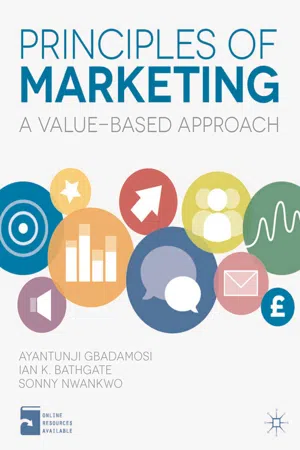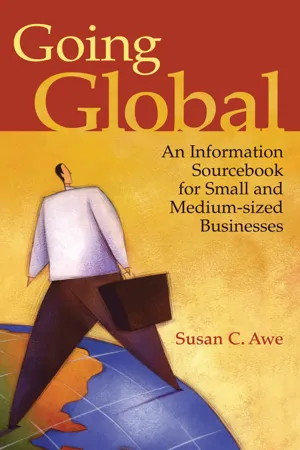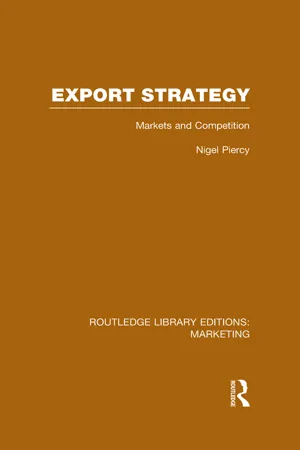Marketing
Exporting
Exporting refers to the process of selling goods or services produced in one country to another. It involves various activities such as market research, pricing, distribution, and promotion to reach international customers. Exporting allows businesses to expand their market reach, increase sales, and diversify their customer base.
Written by Perlego with AI-assistance
Related key terms
1 of 5
8 Key excerpts on "Exporting"
- eBook - ePub
- Kenneth D. Weiss(Author)
- 2011(Publication Date)
- Wiley(Publisher)
6Marketing in the United States and AbroadHowever you start your business, with a buyer or with a product, your long-term success will depend very much on your skills in marketing. For import and export merchants the most critical business functions are purchasing and marketing, and the job of an import or export agent is almost entirely marketing.WHAT IS MARKETING?
Traditionally, marketing is described as the group of activities required to move goods and services from producers to consumers in order to satisfy consumers’ needs and wants. Consumers can be either individuals or industrial organizations including wholesalers and retailers, manufacturing companies, hospitals, restaurants, government entities, and so on. The major functions of marketing—the famous four Ps—are product, price, promotion, and place. The word “product” refers to the product and all its characteristics including its package and label. The word “price” includes the intricacies of pricing at all levels in the channel of distribution. “Promotion” includes advertising, public relations, and other ways of enticing consumers to buy the product or service, and “place” refers to the distribution system, which ends in a place where the final buyer (consumer or industrial) can obtain the product. In this age of the Internet, the place is often virtual rather than physical.The way the four Ps are combined is referred to as the marketing mix. For example, your imported caviar might be very high in quality, which will obligate you to set a high price. Your exported razor blades might be distributed very widely, which will allow you to spend less money on promoting them. The idea is to blend the four elements in a way that will maximize your profit.In practice, you will probably find yourself rearranging the four Ps. First, you will probably improve your product on the basis of information from potential buyers. Second, you will select one or more target markets and develop a channel of distribution to reach each of them. Third, you will set (or suggest) a price to the final buyer and work back from that, deducting expenses and markups, to calculate the price at which you will sell (assuming you can make a reasonable profit at that price). Finally, you will determine which kinds and amounts of promotion you need to do in order to sell a predetermined amount of merchandise. If your marketing plan includes selling to intermediaries, such as wholesalers or distributors, you should prepare a sell sheet (sales presentation) that you can use when you meet with them. - eBook - PDF
Principles of Marketing
A Value-Based Approach
- Ayantunji Gbadamosi, Ian Bathgate, Sonny Nwankwo(Authors)
- 2013(Publication Date)
- Bloomsbury Academic(Publisher)
Many companies take Exporting as the easiest approach to start their entry into foreign markets. Through this method, firms may not have many liabilities compared with other modes of entry. However, producing goods in a foreign country could sometimes prove much cheaper. There are usually high transportation costs associated with Exporting. In addition, tariff barriers can hinder Exporting. When it comes to value delivery, exporters must work closely with other business partners that have expertise in importing, logistics and distribution. In other words, partnership relationships are crucial so as to have products and services available to end-consumers. Without partnering with other businesses based in the foreign country, the company is unlikely to deliver value through Exporting goods to the customers across borders. For example, any organizations engaged in exports Figure 12.1: Critical resources 350 marketing in a global context require the services of a customs clearing agent and freight forwarder. These partners offer a series of services for managing customs clearance for imports and exports through the ports and airports to ensure a smooth process of Exporting goods to another country. Logistics procedures, including booking air or shipping space and arranging documentation, are handed over to a trusted local company based in the foreign country rather than being handled by the exporter. The host company mainly has the responsibility for product development and production but relies on the contracted firms to complete the rest of the value-added activities based on their expertise. The advantages and disadvantages of Exporting are summarized in Table 12.1. - eBook - ePub
- The Staff of Entrepreneur Media, Inc., Jason R. Rich(Authors)
- 2021(Publication Date)
- Entrepreneur Press(Publisher)
11Advertising, Marketing, and Distribution
A s an international trader, your mission is sales—in three different but overlapping arenas:1. Knowing what your customers want and need so you can market to their needs and sell accordingly 2. Selling yourself and your company to clients as an import/export manager for their products 3. Selling the products themselves to representatives and distributorsSuccess in any one of these arenas will ultimately contribute to your success in the others. Once you’ve established a favorable sales record with one client’s goods, you’ll have a track record with which to entice other clients. However, don’t fall into the trap of assuming that one size fits all. Each satisfied customer will contribute to your own self-confidence, which will lend that air of confidence to your negotiations with new prospects.So, which comes first, selling the product or yourself? The answer is: neither. Knowing the wants and needs of your customers (as well as potential customers and clients) comes first. You could have a great product or be a great salesman, but if your customers don’t want or need what you’re selling, you’re out of luck.Next, you’ll need to sell your company and yourself, because until you have a client’s trust, you’re not going to get very far. Marketing your import/export management company involves two main steps:1. Convincing a prospective client that they have a product worth Exporting to customers who want what they’re selling 2. Persuading a potential client that you’re operating a company that they can trust to do the jobHunting for Exports
A surprisingly small percentage of domestic producers export their wares. Your marketing goal is to convince the huge remainder that they can increase profits by Exporting—with your guidance—to specific target countries. You can accomplish this through targeted emails (not spam), making connections through in-person or online networking, via social media, or by attending trade shows. Cold calling (telemarketing) is also an option, but it’s time consuming, and getting people to answer their phone these days is very difficult. - eBook - PDF
- Sharma, Premjit(Authors)
- 2021(Publication Date)
- Genetech(Publisher)
Some firms never get any further than the Exporting stage. Marketing overseas can, therefore, be anywhere on a continuum of “foreign” to “global”. It is well to note at this stage that the words “international”, “multinational” or “global” are now rather outdated descriptions. In fact “global” has replaced the other terms to all intents and purposes. “Foreign” marketing means marketing in an environment different from the home base, it’s basic form being “Exporting”. Over time, this may evolve into an operating market rather than a foreign market. One such example is the Preferential Trade Area (PTA) in Eastern and Southern Africa where involved countries can trade inter-regionally under certain common modalities. Another example is the Cold Storage Company of Zimbabwe. In “global marketing” the modus operandi is very different. Organisations begin to develop and run operations in the targeted country or countries outside of the domestic one. In practice, organisations evolve and Table 1 outlines a typology of terms which describes the characteristics of companies at different stages in the process of evolving from domestic to global enterprises. The four stages are as follows: 1. Domestic in focus, with all activity concentrated in the home market. Whilst many organisations can survive like this, for example raw milk marketing, solely domestically oriented organisations are probably doomed to long term failure. 2. Home focus, but with exports (ethnocentric). Probably believes only in home values, but creates an export division. Usually ripe for the taking by stage four organisations. 3. Stage two organisations which realise that they must adapt their marketing mixes to overseas operations. The focus switches to multinational (polycentric) and adaption becomes paramount. 4. Global organisations which create value by extending products and programmes and focus on serving emerging global markets (geocentric). - eBook - PDF
- Michael Czinkota, Ilkka Ronkainen, Annie Cui, , Michael Czinkota, Ilkka Ronkainen, Annie Cui(Authors)
- 2022(Publication Date)
- Cengage Learning EMEA(Publisher)
16 As can be expected, firms in different stages are faced with different problems. Firms at the export awareness and interest stages are primarily concerned with operational matters such as information flow and the mechanics of carrying out international business transactions. They understand that a totally new body of knowledge and expertise is needed and try to acquire it. Companies that have already had some exposure to international markets via trial or evaluation begin to think about tactical marketing issues such as communication and sales effort. Finally, firms that have reached the export adaptation phase are mainly strategy- and service-oriented. They worry about longer-range issues such as service delivery and regulatory changes. Increased sophistication in international markets translates into increased application of marketing knowl-edge on the part of firms. The more they become active in international markets, the more firms recognize that a marketing orientation is just as essential internationally as it is in the domestic market. Firms who choose to export their products may do so in a number of different ways. They may export directly or use export intermediaries such as export management companies or trading compa-nies. They can also sell to a domestic firm that in turn sells abroad. For example, many products sold to multinational corporations are used as input for their global sales. Increasingly, however, firms are also Exporting their products through specific e-commerce platforms such as Amazon. Market intermediaries specialize in bringing firms or their goods and services to the global mar-ket. Often, they have detailed information about the competitive conditions in certain markets or have personal contacts with potential buyers abroad. They can also evaluate credit risk, call on customers abroad, and manage the physical delivery of the product. Two key intermediaries are export manage-ment companies and trading companies. - eBook - PDF
Going Global
An Information Sourcebook for Small and Medium-Sized Businesses
- Susan C. Awe(Author)
- 2009(Publication Date)
- Libraries Unlimited(Publisher)
3 Market Analysis/ Competitive Strategy Chapter Highlights: Where to Begin? Screening Potential Markets for Exporting Identify Your Competitors and Research Their Export/Import Efforts Data Gathering Choosing the Right Market Develop Your Export Marketing Plan Accidental Exporting Economies all over the world are developing or just changing, and market development takes time. Flexibility and political astuteness are important. Remember that if you plan your export venture thoroughly and with care, you have a better chance of success in your target market and elsewhere. Many small and medium-sized enterprises (SMEs) start export ventures with inadequate market studies or none at all. Yet a market study is almost the only way to support your income (sales) projects and your marketing plan. In addition, a solid market study looks very good to potential investors and lenders. Your international market research may take different forms as there are many ways to study a market. Remember that the more detailed your research, the less likely you are to overlook something important. To be successful, assess your potential markets to identify your marketing oppor- tunities and constraints within individual foreign markets and also to identify and find prospective buyers and customers through market research. In markets that are vastly different from the domestic market, some products or services will have limited potential. Differences may stem from social and cultural factors, climate and environmental factors, availability of raw mate- rials or product alternatives, lower purchasing power, government import controls, and the like. Look at why your product or service sells well in the domestic market and then select similar markets abroad. The main two types of market research are primary and secondary. - Nigel Piercy(Author)
- 2014(Publication Date)
- Routledge(Publisher)
Closely related to the export strategy adopted, in the choice of market targets, is the question of how the exporter competes, or what competitive differentiation exists to attract and hold export business. The debate in this area has been between the traditional reliance on price competition in Exporting, and the development of non-price aspects of export marketing.The approach to these problems which will be taken in this volume is one which has been described as a situational or contingency view, which relies on the analysis of the specific surrounding factors in particular cases, rather than producing general rules to be followed inflexibly (or perhaps more probably ignored as being unrealistic).The underlying need for this type of view in marketing – at home as well as abroad – arises from the fact that we really do not have a single, universally valid way of looking at the world and making decisions, so what we offer the manager has to consist of methods of analysing situations and theories that predict the implications of the various options faced.The objectives of the book are as follows: (a) to build a framework which fully identifies the options faced in export market strategy and isolates the factors which determine the relative attractiveness of the strategic options in different situations, and (b) to construct guidelines to the major aspects of export competition – price and non-price factors – and the problems in managing change from one form of competition to another, and the factors favouring the alternative competitive bases.Exporting and export marketing
In defining the precise meaning of Exporting and the scope of this book about Exporting, we find that the terms used to describe international trading are often applied relatively loosely, so there is a need to reach some agreement, however arbitrary, on the meaning of Exporting and export marketing to be used.To begin, while the distinction between domestic sales and overseas sales is reasonably straightforward, it is less easy to draw the dividing line between Exporting and international business on a broader scale. Summarising the positions taken by established authorities in the area (Tookey, 1969 ; Kotler, 1972 ) allows the inclusion of direct sales from the home market to foreign users, distributors or agents, and the use of the various forms of joint venturing to establish overseas marketing subsidiaries, as export. On the other hand, international business- eBook - PDF
- Ian Chaston(Author)
- 2013(Publication Date)
- Red Globe Press(Publisher)
They believe that operating overseas is a risky, uncertain activity, and gaining access to new markets is a critical factor influencing performance. ● Active exporters: committed to developing overseas markets and see Exporting as an important source of future revenue. They do not see Exporting as an uncertain activity and gaining market access is not a critical issue. They emphasize developing internal competences in identifying optimal opportunities, determining appropriate marketing actions, and resolving operating problems that might arise in overseas markets. In a large-scale research project covering Canadian and UK small firms, Beamish et al. (1993) sought to empirically determine the influence on performance in overseas markets of geographic coverage, commitment to Exporting, distribution selection, and 260 Small Business Marketing marketing activities. In relation to geographic coverage, the study showed that small firms that operated across a number of overseas markets can expect to outperform their counterparts serving one or two markets. The authors concluded that this reflects an evolutionary process; as a firm gains experience in a limited number of markets, success stimulates owner-managers to initiate a market expansion programme. In Canada and the UK, there was a clear relationship between the firm’s level of commitment to Exporting and their success in overseas markets. In relation to distribution, the more successful firms are those that concentrated on developing long-term relationships with members of a single channel. Analysis of marketing activities revealed that another contributor to success was the ability to offer a broad product line and when operating across numerous markets, a willingness to modify products to suit differing needs in different countries. Another important factor influencing performance is the creation of a sales force dedicated to the management of overseas trading activities.
Index pages curate the most relevant extracts from our library of academic textbooks. They’ve been created using an in-house natural language model (NLM), each adding context and meaning to key research topics.







